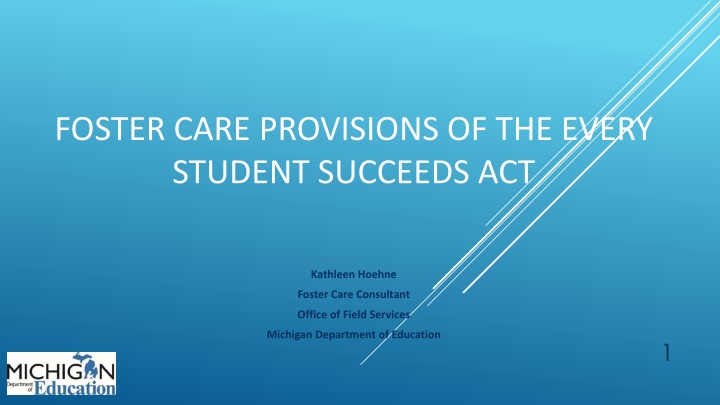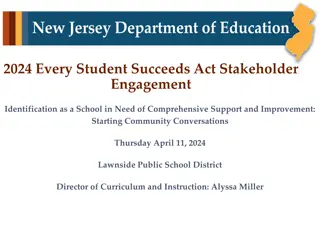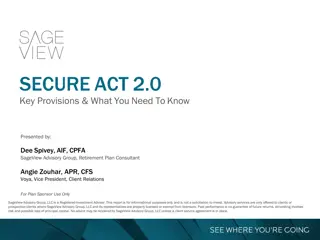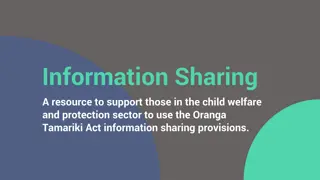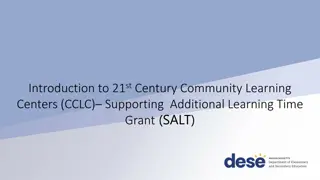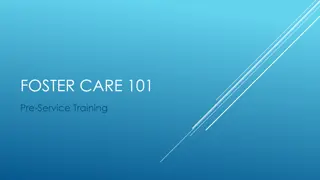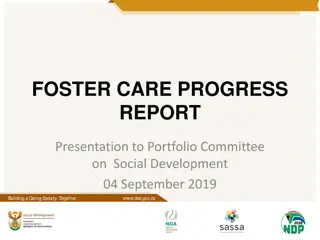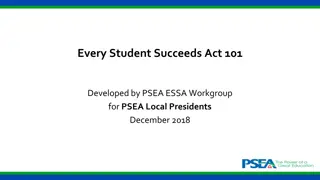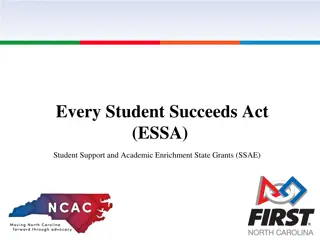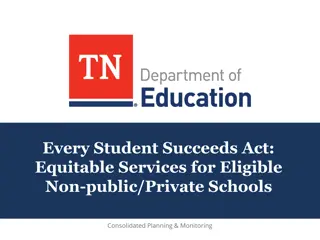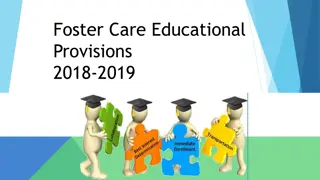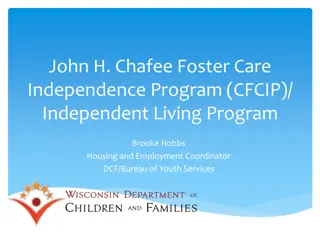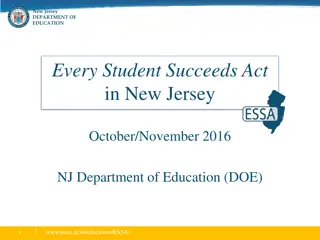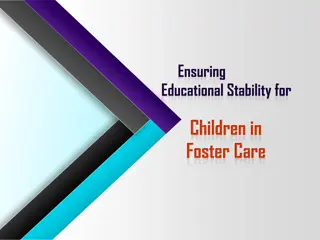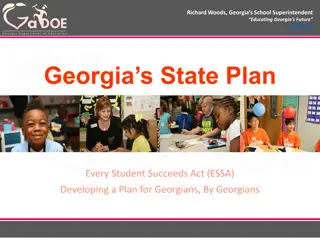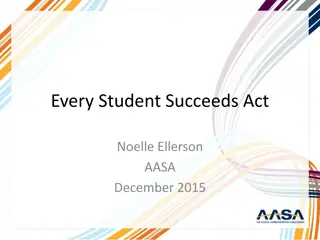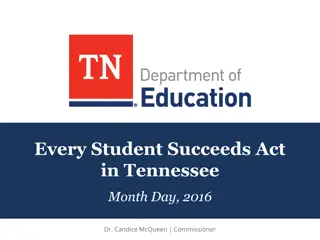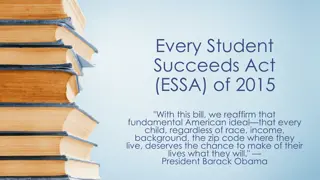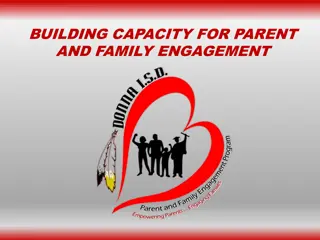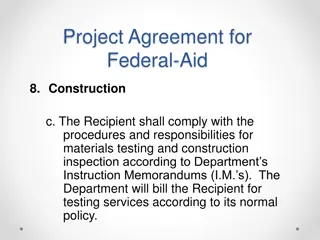Foster Care Provisions of Every Student Succeeds Act
National and Michigan statistics highlight the challenges faced by youth in foster care. The Every Student Succeeds Act of 2015 aims to ensure students in foster care receive support and opportunities for academic success. The act emphasizes high academic standards, data reporting, and protections for disadvantaged students.
Download Presentation

Please find below an Image/Link to download the presentation.
The content on the website is provided AS IS for your information and personal use only. It may not be sold, licensed, or shared on other websites without obtaining consent from the author.If you encounter any issues during the download, it is possible that the publisher has removed the file from their server.
You are allowed to download the files provided on this website for personal or commercial use, subject to the condition that they are used lawfully. All files are the property of their respective owners.
The content on the website is provided AS IS for your information and personal use only. It may not be sold, licensed, or shared on other websites without obtaining consent from the author.
E N D
Presentation Transcript
FOSTER CARE PROVISIONS OF THE EVERY STUDENT SUCCEEDS ACT Kathleen Hoehne Foster Care Consultant Office of Field Services Michigan Department of Education 1
TODAYS AGENDA National Statistics from FY 2016 Michigan Statistics from FY 2015 Every Student Succeeds Act of 2015 oState Requirements oLocal District Requirements oPoints-of-Contact Responsibilities Transportation Collaboration 2
NATIONAL STATISTICS FOR YOUTH EXPERIENCING FOSTER CARE National Foster Youth Institute- 2016 Approximately 400,000+ children nationally are in foster care Higher rate of mobility during the school year Higher rate of identification for special education Dropout rate three times higher than non-foster youth Approximately 50% drop out of high school Over 40% experience educational difficulties (suspension/expulsion, segregation from peers, relational issues, etc.) Less than 3% attain a four-year post-secondary degree *ALMOST EVERY YOUTH EXPERIENCED TRAUMA 3
MICHIGAN STATISTICS FOR YOUTH EXPERIENCING FOSTER CARE In Michigan for the FY 2015: 12,248 children were in care on Sept 30th 6,982 children entered foster care 7,360 children exited foster care 3,875 children were awaiting adoption 3,466 children s parental rights were terminated 1,765 children were adopted *ALMOST EVERY YOUTH EXPERIENCED TRAUMA 4
EVERY STUDENT SUCCEEDS ACT OF 2015 (ESSA) New Federal Education Law o Passed in December 2015 Updates Elementary and Secondary Education Act (ESEA) Replaces the No Child Left Behind Act Amends the McKinney-Vento Homeless Assistance Act Identifies new responsibilities at State and LEA levels 5
EVERY STUDENT SUCCEEDS ACT OF 2015 Requires, for the first time, that ALL students be taught to high academic standards that will prepare them to succeed in college and career. Requires new federal data reporting for graduation and dropout, academic achievement for three new subgroups including students in foster care. Guarantees steps are taken to help students and their schools improve. Upholds critical protections for disadvantaged and high-need students, including students experiencing foster care and homelessness. 6
ESSA MCKINNEY-VENTO AMENDMENTS ESSA amends the McKinney-Vento Homeless Assistance Act and removes the term awaiting foster care placement from the definition of homeless. As of December 10, 2016, awaiting foster care placement was removed from the law. Youth experiencing foster care will NO LONGER automatically be considered homeless under McKinney-Vento. *Foster youth can no longer receive district MV services on the basis of foster status alone. 7
ESSA - FOSTER CARE PROVISIONS, STATE State Title I Plan Must describe the steps that the State Education Agency (SEA) will take to ensure collaboration with state child welfare agency to ensure education stability of students who are experiencing foster care: The SEA must designate a state Point of Contact for child welfare agencies and LEAs, who will oversee the implementation of these responsibilities at the LEA level. o This person cannot be the same as the State Coordinator for McKinney-Vento Programs. (It can be at LEA level). Collaborate with the state agency responsible for administering state plans under the Fostering Connections Act and LEAs. 8
ESSA - FOSTER CARE PROVISIONS, LOCAL Local Title I Plans: *Must contain assurances that the local education agency will collaborate with the child welfare agency and: Designate a foster care liaison point of contact in the Educational Entity Master (EEM) by September 6, 2016. Develop and implement procedures for how transportation to maintain foster youth in their schools of origin, when in their best interest, will be provided, arranged and funded. Develop procedures to maintain foster youth in their school of origin during any dispute around transportation funding. 9
MICHIGAN DEPARTMENT OF EDUCATION (MDE) MEMOS MDE has issued three separate Memos to the field regarding the identification of a district foster care liaison in the EEM. August 25, 2016 August 16, 2017 September 18, 2017 *NOTE: Title I, Part A funds approved in districts 2017-18 Consolidated Application will NOT be available until a person is identified and entered into the EEM as the foster care liaison. Directions for entering information into the EEM are available on the MDE-OFS website. 10
*Person entering information must have appropriate privileges in the EEM Locate the Foster Care Liaison on drop-down Open the entity Entity information page has its own toolbar, click Edit Entity Click on Admin/Contacts tab found at the bottom Click on the Add Contact button Complete the required information Make sure to click the Save button or additions will not be applied 11 WWW.MICHIGAN.GOV/EEM
NOTIFICATION AND RECORDS RELEASE FORM The DHS-942, Education Notification and Record Release form is required to be sent to the foster care liaison at the school: o When a student first enters foster care, whether a school move is required or not. o Any time a student moves foster home placements while in care, whether a school move is required or not. o Any time a student transfers schools. o When a case worker is completing the case service plan. 12
BEST INTEREST FACTORS Foster care workers must consider the following factors regarding school placement: oThe parents or guardians and child s school of preference. oEducational input from school personnel and district liaison. oThe child s/youth s: Social and emotional state Academic achievement/strengths/weaknesses Continuity of relationships Special education programming Extra-curricular activity participation Distance/travel time to and from current school/new placement and the impact of commute on the child Supportive relationships and/or services Length of anticipated stay in placement and permanency plan 13
BEST INTEREST FACTORS ADDITIONAL QUESTIONS How would changing schools affect the child or youth s ability to earn full academic credit, proceed to the next grade or graduate on time? How many schools has the child attended over the past few years? What schools do the siblings attend? Can a move wait until the end of a semester? 14
MICHIGAN REVISED SCHOOL CODE ACT 451 MCL 380.1148(2) In 2009, Michigan revised the school code: A school district must allow a student to enroll in and attend the appropriate grade in the school selected by the Department of Health and Human Services or a child placing agency without regard to whether or not the student is residing in that district. If the selection results in a student transferring to another school, the school records must immediately be transferred to that new school. 15
EDUCATION RECORDS TRANSFER Each time a child/youth moves home placements, the caseworker must provide the new placement with ANY AVAILABLE education records at time of placement or within TWO weeks. This includes an initial placement, replacements to new foster home/relative, or reunification. It is the schools responsibility to provide any current records for a student whose placement is changing. 16
MDHHS STATE EDUCATION ANALYST Write education policy for foster care manuals. Provide regular ongoing training and technical assistance to Education Planners, Points-of-Contact, and other child welfare staff across the state. Maintain updated MDHHS Points-of-Contact list. Maintain an updated MDHHS ESSA page on the public MDHHS website. 17
MDHHS EDUCATION PLANNERS Specialized MDHHS staff that work with youth age 14 and up with open foster care cases on education issues. 14 planners that currently cover 34 counties. Receive regular, ongoing detailed training: Federal and state education law and policy Federal and state child welfare law and policy Special Education Best interest determination Higher education preparation and resources Older youth resources 18
MDHHS EDUCATION POINTS-OF-CONTACT RESPONSIBILITIES In counties with an Education Planner, they may be the identified POC. For Education Planners that cover multiple counties, different POCs may be identified in some counties. Received initial training about education law and the changes regarding transportation. Received specialized training and technical assistance on process for transportation payment. Tasked with getting information to child welfare staff at MDHHS and private agencies. 19
MDHHS EDUCATION POINTS-OF-CONTACT RESPONSIBILITIES CONT. Serve as main go-to person for district foster care liaison. Provide technical assistance and support to foster care caseworkers as they: o Notify school districts when a child has been placed in foster care in the LEA, moves out of the LEA, or when a foster care placement changes. o Coordinate transportation plans and payment. o Make Best Interest Determinations. 20
FOSTER CARE CASE WORKER RESPONSIBILITIES Foster care case workers have full case responsibility. Although Education Planners and Points-of-Contact can assist, it is the assigned case worker s responsibility to ensure education continuity for children/youth. Foster care case workers report quarterly on all case progress to the court. This includes education. 21
Additional information to help locate district foster care liaisons and MDHHS Education Point-of-Contact MDHHS WEBSITE PAGE CONT. 23
STATE FOSTER CARE POINT OF CONTACT RESPONSIBILITIES State point of contact for the education of foster youth responsibilities will include but may not be limited to: Provide professional development opportunities and technical assistance for LEA foster care liaison and other personnel regarding school stability and educational supports for children in foster care. 24
STATE POINT OF CONTACT FOR FOSTER CARE RESPONSIBILITIES CONT. Coordinate with the corresponding State and tribal child welfare agency POCs to issue joint State guidance for the implementation of the Title I provisions, which include: Establish guidelines for transportation procedures, including how transportation will be addressed across district, county and State lines and what should be included in local transportation procedures. Establish uniform criteria around the best interest determination factors. 25
STATE POINT OF CONTACT FOR FOSTER CARE RESPONSIBILITIES CONT. 2 Facilitate data sharing with State and tribal child welfare agencies, consistent with FERPA and other Federal or State privacy laws, regulations, and policies. Monitor LEAs to ensure compliance with the Title I requirements at the local level. For the 2018-2019 SY each LEA will be responsible for uploading Foster Care Transportation Procedures into GEMS by Oct 1, 2018 26
DISTRICT FOSTER CARE LIAISON RESPONSIBILITIES District foster care liaison responsibilities will include but may not be limited to: Ensure that children in foster care are IMMEDIATELY enrolled in and are regularly attending school. Provide technical assistance to school staff on the Title I provisions and educational needs of children in foster care, as needed. Ensure transportation procedures are in place to maintain students in their school of origin, when determined to be in their best interest. 27
DISTRICT FOSTER CARE LIAISON RESPONSIBILITIES CONT. Coordinate with the county MDHHS POC on the implementation of the Title I provisions: Participate with best interest determinations. Implementation of the Title I provisions of ESSA (including immediate enrollment and transportation arrangements). Develop LEA/regional transportation procedures. Transportation costs agreements between the LEA and the child welfare agency. 28
TRANSPORTATION REIMBURSEMENT CHANGES Beginning February 1, 2018, the structure for reimbursing additional costs for transporting foster students to their school of origin if determined to be in his/her best interest, will be as follows; If a student placement is eligible to receive Title IV-E funds, MDHHS will reimburse additional transportation costs at 100% If a student placement is not eligible to receive Title IV-E funds, MDHHS will reimburse additional transportation costs at the rate of 50% and the district is responsible for the remaining 50% 29
TRANSPORTATION REIMBURSEMENT CHANGES CONT. Child Welfare Workers have 30 days to make Title IV-E eligibility determination and notify LEAs. During the window of Title IV-E eligibility determinations, LEAs are responsible for providing transportation with possible 100% or 50% reimbursement from MDHHS. Child Welfare Workers are responsible for notifying LEAs if student Title IV-E eligibility changes. LEAs can use Title I, Part A funds to cover non-reimbursed costs for additional costs to transport students to school of origin. 30
TRANSPORTATION PAYMENT If additional costs for transportation are eligible for reimbursement payment from MDHHS comes from Central Office allocation. Payment can be made to a transportation company, a school district, a foster parent/relative. Anyone receiving payment must be registered in SIGMA (formally MAIN). When payment is going to the district, the school can provide a certification letter/bill each month, listing what was paid for, for what days, the cost and signed by the district designee. This information is sent to the case worker. 31
DEFINITION OF ADDITIONAL COSTS FOR TRANSPORTATION Additional costs incurred in providing transportation to the school of origin should reflect the difference between what an LEA otherwise would spend to transport a student to his or her assigned school and the cost of transporting a child in foster care to his or her school of origin. *Non-Regulatory Guidance Question #27 32
TRANSPORTATION COLLABORATION LEA POC and MDHHS POC should collaborate to: Develop formalized local processes for Best Interest Determination. Look at ALL available transportation plans and options: Re-routing school busses District A does morning run and district B does afternoon run Transport student to old bus stop in school of origin Using school vans Public transportation passes Gas cards to foster parent/relative 33
RESOURCES Nonregulatory Guidance Foster care Nonregulatoryguide Dear Colleague Letters https://www2.ed.gov/policy/elsec/leg/essa/edhhsfostercaredcl.pdf https://www2.ed.gov/policy/elsec/leg/essa/edhhseffectivedatesdcl.pdf State of Michigan Websites http://www.michigan.gov/mde/0,4615,7-140-6530_30334_51051-428655--,00.html http://www.michigan.gov/mdhhs/0,5885,7-339-71551_11120_78699---,00.html Children s Bureau https://www.acf.hhs.gov/cb/resource/trends-in-foster-care-and-adoption-fy15 34
QUESTIONS Kathleen Hoehne hoehnek@Michigan.gov 517-373-4004 35
